FRM News Flash – July 2020
The HALO Initiative
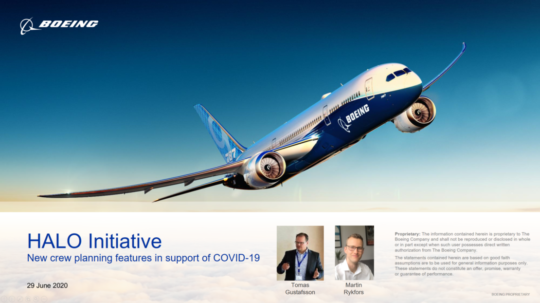
Due to the on-going Covid-19 crisis, many airlines have quickly implemented quite dramatic changes to their crew planning processes recently, managing to do what many would consider almost impossible in the given time frame. Examples range from rule changes, enhanced teaming of pilots and cabin crew, to publication of crew rosters one week at a time instead of monthly.
As a result of working with many of these operators, and recognising similarities between them, Jeppesen has launched what we call the HALO Initiative. HALO was first presented to the industry in a webinar in late June and the initiative consolidates the work done into easily installed plug-ins to the Jeppesen Crew solution suite.
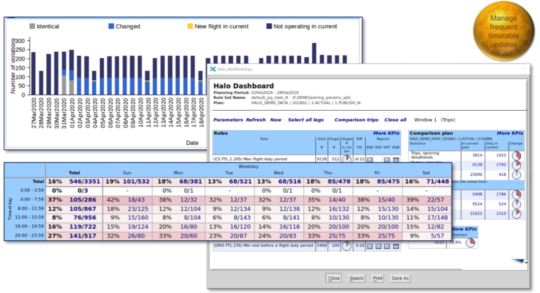
The areas initially in focus for HALO, being recurring patterns, are dealing with destination restrictions, exposure and improved management of high volatility in timetables. At this point, HALO introduces the following packages for Jeppesen Crew Pairing and Rostering users:
- Destination Restrictions: rules for how crew are allowed to combine destinations in their rosters. Example: ‘Crew that visit station X, cannot go to station Y for N number of days’
- Timetable analysis: Quickly understanding the changes imposed by an updated timetable, supporting taking the right planning decisions. Provides overview and detailed analysis for understanding the difference between pairing solutions, and builds on the Jeppesen Calibration functionality.
- Reporting: This package gives the means to directly produce reports in Excel format for efficient communication with other stakeholders not having access to Jeppesen systems.
- Crew Teaming: minimizing exposure for crew to others, while building operationally robust pairings and rosters.
The HALO packages are available to Jeppesen crew solution customers through the normal service/support organization and have been built to support both manual planning and analysis, but also fully automatic optimization runs that simultaneously consider all other objectives (including fatigue risk using BAM).
Fatigue Risk Modelling Supporting ‘Special Operations’
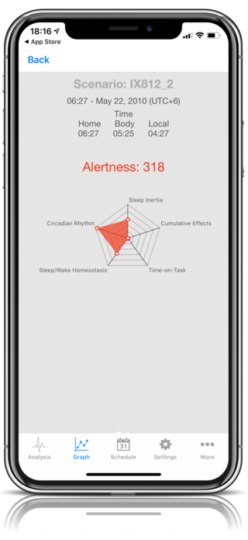 Recently, Jeppesen has assisted several operators with fatigue risk modelling for performing what is referred to as ‘special operations’. It has been in response to new restrictions on crew layovers, new scheduling patterns and for example ‘repatriation flights’ that go beyond current regulatory rules.
Recently, Jeppesen has assisted several operators with fatigue risk modelling for performing what is referred to as ‘special operations’. It has been in response to new restrictions on crew layovers, new scheduling patterns and for example ‘repatriation flights’ that go beyond current regulatory rules.
A very capable and useful tool for quickly doing what-if scenarios is CrewAlert Pro. CrewAlert allows for full control of all assumptions, entering any roster pattern and comparing alternative options regarding predicted levels of crew alertness using BAM, as well as comparison of a large number of additional safety performance indicators. Documentation to assist you here is how to deal with scenarios in CrewAlert, investigating fatigue causes, and BAM safety performance indicators.
In case you are one of the operators now facing a need for modelling, comparing and finding the best options for a certain operation, please don’t hesitate to contact us for further advice and material.
Why Sleep Matters More Now Than Ever
A good night’s sleep has perhaps never been more important . Sharing wisdom and debunking myths, sleep scientist Matt Walker discusses the impact of sleep on mind and body — from unleashing your creative powers to boosting your memory and immune health — and details practices you can start (and stop) doing tonight to get some rest. You will find this TED talk discussion through this link.
. Sharing wisdom and debunking myths, sleep scientist Matt Walker discusses the impact of sleep on mind and body — from unleashing your creative powers to boosting your memory and immune health — and details practices you can start (and stop) doing tonight to get some rest. You will find this TED talk discussion through this link.
Webinar on Mentally Healthy Workplaces
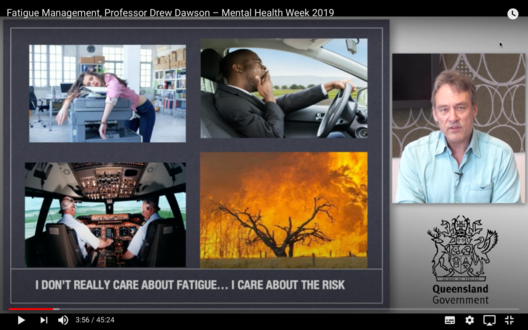
Workplace Health and Safety Queensland (Australia) just recently published a webinar with Professor Drew Dawson, as part of Safe Work Month which is celebrated nationally throughout October in Queensland.
Professor Drew Dawson is nationally and internationally recognised for his contributions to the scientific community and to industry in the areas of sleep and fatigue research, organisational psychology and human behaviour, industrial relations negotiations, and the human implications of hours of work. As Director of the internationally recognised Appleton Institute, he oversees basic and applied research into the effects of shift work and sleep loss on the health and well-being of employees.
Please find the webinar, titled “Mentally Healty Workplaces, managing fatigue in the modern world”, via this link.
Automatic Trend Detection of Meaningful SPIs
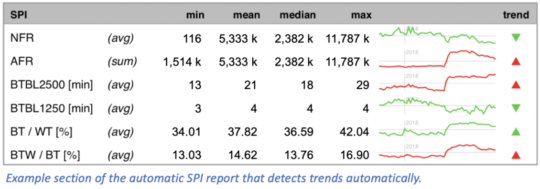
What matters to the fatigue risk on an individual flight is what ‘leads in’ to that situation for the crew. For example, it will matter how much sleep crew obtained in the 24 hours prior, 48 hours prior and perhaps also in the full week prior to that operation. Similarly, the time awake prior to the flight will also be of importance. We refer to this as the ‘flight context’; what took place prior to a flight, from a multitude of different aspects. It may be the amount of duty time touching the physiological night, number of landings or duration of sleep opportunity; keeping in mind that the closer in time that it happened, the greater effect it will have on the state of the crew. If crew had a night duty a couple of weeks prior to the departure of the flight in question, it would have a much smaller impact on the state of the crew, compared to such a duty being placed on the night before.
A bio-mathematical model will of course take the flight 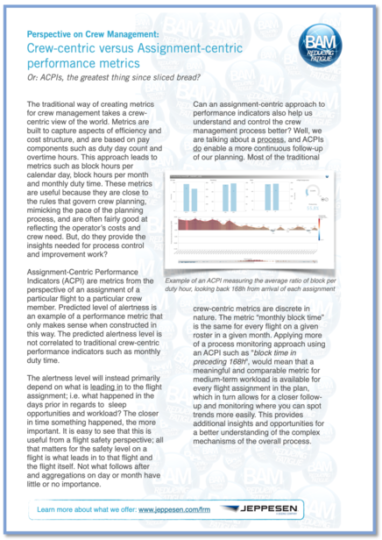 context into account when predicting alertness for the flight – but it will do so only for aspects that the scientific community has been able to quantify and validate from collected data. Knowing that the scientists are short of representative data, and recognizing that fatigue models are not perfect today, it is best practice to also track the development of additional metrics over time, calculated from the crew roster. Some airlines simply use for this what they have available; number of rule exceedances, remaining margin to maximum FDP, monthly block hours etc. The disadvantage with such an approach is that these traditional metrics do not reflect the flight context; what really leads up to each flight. The amount of block hours in June has of course little or no bearing on the fatigue risk of a flight departing on, say, the 5th of June. You will need what we refer to as Assignment Centric Performance Indicators (ACPIs).
context into account when predicting alertness for the flight – but it will do so only for aspects that the scientific community has been able to quantify and validate from collected data. Knowing that the scientists are short of representative data, and recognizing that fatigue models are not perfect today, it is best practice to also track the development of additional metrics over time, calculated from the crew roster. Some airlines simply use for this what they have available; number of rule exceedances, remaining margin to maximum FDP, monthly block hours etc. The disadvantage with such an approach is that these traditional metrics do not reflect the flight context; what really leads up to each flight. The amount of block hours in June has of course little or no bearing on the fatigue risk of a flight departing on, say, the 5th of June. You will need what we refer to as Assignment Centric Performance Indicators (ACPIs).
Jeppesen Concert is a cloud-based self-service analytics solution designed for quantifying and monitoring, not only fatigue risk using a leading fatigue model (BAM), but also a wide range of truly meaningful SPIs reflecting the flight context for all flights in your operation. Concert allows for powerful data exploration and analytics and also automatically detect trends in your data, alerting you accordingly.
Please consider contacting us here to receive more information on how to get up and running with a Concert trial. Concert can be used with your current crew management solution and does not require any local installation. In as little as a week from now, you could be analysing trends of a large range of meaningful SPIs over the last few years for your operation; comparing planned to published. And published to operated. Welcome!
Meet up with the Jeppesen experts
OCT 29-31: Annual DGSM Meeting, Essen, Germany
Many events continue to be cancelled or re-scheduled due to COVID-19. Please drop us an email here instead if you would like to schedule a call or a webex demo.
jeppesen.com/frm
+46 31 720 81 00
Send us an Email
The HALO Initiative

Due to the on-going Covid-19 crisis, many airlines have quickly implemented quite dramatic changes to their crew planning processes recently, managing to do what many would consider almost impossible in the given time frame. Examples range from rule changes, enhanced teaming of pilots and cabin crew, to publication of crew rosters one week at a time instead of monthly.
As a result of working with many of these operators, and recognising similarities between them, Jeppesen has launched what we call the HALO Initiative. HALO was first presented to the industry in a webinar in late June and the initiative consolidates the work done into easily installed plug-ins to the Jeppesen Crew solution suite.

The areas initially in focus for HALO, being recurring patterns, are dealing with destination restrictions, exposure and improved management of high volatility in timetables. At this point, HALO introduces the following packages for Jeppesen Crew Pairing and Rostering users:
- Destination Restrictions: rules for how crew are allowed to combine destinations in their rosters. Example: ‘Crew that visit station X, cannot go to station Y for N number of days’
- Timetable analysis: Quickly understanding the changes imposed by an updated timetable, supporting taking the right planning decisions. Provides overview and detailed analysis for understanding the difference between pairing solutions, and builds on the Jeppesen Calibration functionality.
- Reporting: This package gives the means to directly produce reports in Excel format for efficient communication with other stakeholders not having access to Jeppesen systems.
- Crew Teaming: minimizing exposure for crew to others, while building operationally robust pairings and rosters.
The HALO packages are available to Jeppesen crew solution customers through the normal service/support organization and have been built to support both manual planning and analysis, but also fully automatic optimization runs that simultaneously consider all other objectives (including fatigue risk using BAM).
Fatigue Risk Modelling Supporting ‘Special Operations’
 Recently, Jeppesen has assisted several operators with fatigue risk modelling for performing what is referred to as ‘special operations’. It has been in response to new restrictions on crew layovers, new scheduling patterns and for example ‘repatriation flights’ that go beyond current regulatory rules.
Recently, Jeppesen has assisted several operators with fatigue risk modelling for performing what is referred to as ‘special operations’. It has been in response to new restrictions on crew layovers, new scheduling patterns and for example ‘repatriation flights’ that go beyond current regulatory rules.
A very capable and useful tool for quickly doing what-if scenarios is CrewAlert Pro. CrewAlert allows for full control of all assumptions, entering any roster pattern and comparing alternative options regarding predicted levels of crew alertness using BAM, as well as comparison of a large number of additional safety performance indicators. Documentation to assist you here is how to deal with scenarios in CrewAlert, investigating fatigue causes, and BAM safety performance indicators.
In case you are one of the operators now facing a need for modelling, comparing and finding the best options for a certain operation, please don’t hesitate to contact us for further advice and material.
Why Sleep Matters More Now Than Ever
A good night’s sleep has perhaps never been more important . Sharing wisdom and debunking myths, sleep scientist Matt Walker discusses the impact of sleep on mind and body — from unleashing your creative powers to boosting your memory and immune health — and details practices you can start (and stop) doing tonight to get some rest. You will find this TED talk discussion through this link.
. Sharing wisdom and debunking myths, sleep scientist Matt Walker discusses the impact of sleep on mind and body — from unleashing your creative powers to boosting your memory and immune health — and details practices you can start (and stop) doing tonight to get some rest. You will find this TED talk discussion through this link.
Webinar on Mentally Healthy Workplaces

Workplace Health and Safety Queensland (Australia) just recently published a webinar with Professor Drew Dawson, as part of Safe Work Month which is celebrated nationally throughout October in Queensland.
Professor Drew Dawson is nationally and internationally recognised for his contributions to the scientific community and to industry in the areas of sleep and fatigue research, organisational psychology and human behaviour, industrial relations negotiations, and the human implications of hours of work. As Director of the internationally recognised Appleton Institute, he oversees basic and applied research into the effects of shift work and sleep loss on the health and well-being of employees.
Please find the webinar, titled “Mentally Healty Workplaces, managing fatigue in the modern world”, via this link.
Automatic Trend Detection of Meaningful SPIs

What matters to the fatigue risk on an individual flight is what ‘leads in’ to that situation for the crew. For example, it will matter how much sleep crew obtained in the 24 hours prior, 48 hours prior and perhaps also in the full week prior to that operation. Similarly, the time awake prior to the flight will also be of importance. We refer to this as the ‘flight context’; what took place prior to a flight, from a multitude of different aspects. It may be the amount of duty time touching the physiological night, number of landings or duration of sleep opportunity; keeping in mind that the closer in time that it happened, the greater effect it will have on the state of the crew. If crew had a night duty a couple of weeks prior to the departure of the flight in question, it would have a much smaller impact on the state of the crew, compared to such a duty being placed on the night before.
A bio-mathematical model will of course take the flight  context into account when predicting alertness for the flight – but it will do so only for aspects that the scientific community has been able to quantify and validate from collected data. Knowing that the scientists are short of representative data, and recognizing that fatigue models are not perfect today, it is best practice to also track the development of additional metrics over time, calculated from the crew roster. Some airlines simply use for this what they have available; number of rule exceedances, remaining margin to maximum FDP, monthly block hours etc. The disadvantage with such an approach is that these traditional metrics do not reflect the flight context; what really leads up to each flight. The amount of block hours in June has of course little or no bearing on the fatigue risk of a flight departing on, say, the 5th of June. You will need what we refer to as Assignment Centric Performance Indicators (ACPIs).
context into account when predicting alertness for the flight – but it will do so only for aspects that the scientific community has been able to quantify and validate from collected data. Knowing that the scientists are short of representative data, and recognizing that fatigue models are not perfect today, it is best practice to also track the development of additional metrics over time, calculated from the crew roster. Some airlines simply use for this what they have available; number of rule exceedances, remaining margin to maximum FDP, monthly block hours etc. The disadvantage with such an approach is that these traditional metrics do not reflect the flight context; what really leads up to each flight. The amount of block hours in June has of course little or no bearing on the fatigue risk of a flight departing on, say, the 5th of June. You will need what we refer to as Assignment Centric Performance Indicators (ACPIs).
Jeppesen Concert is a cloud-based self-service analytics solution designed for quantifying and monitoring, not only fatigue risk using a leading fatigue model (BAM), but also a wide range of truly meaningful SPIs reflecting the flight context for all flights in your operation. Concert allows for powerful data exploration and analytics and also automatically detect trends in your data, alerting you accordingly.
Please consider contacting us here to receive more information on how to get up and running with a Concert trial. Concert can be used with your current crew management solution and does not require any local installation. In as little as a week from now, you could be analysing trends of a large range of meaningful SPIs over the last few years for your operation; comparing planned to published. And published to operated. Welcome!
Meet up with the Jeppesen experts
OCT 29-31: Annual DGSM Meeting, Essen, Germany
Many events continue to be cancelled or re-scheduled due to COVID-19. Please drop us an email here instead if you would like to schedule a call or a webex demo.
| jeppesen.com/frm | +46 31 720 81 00 | Send us an Email |
